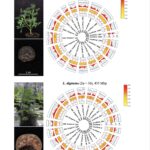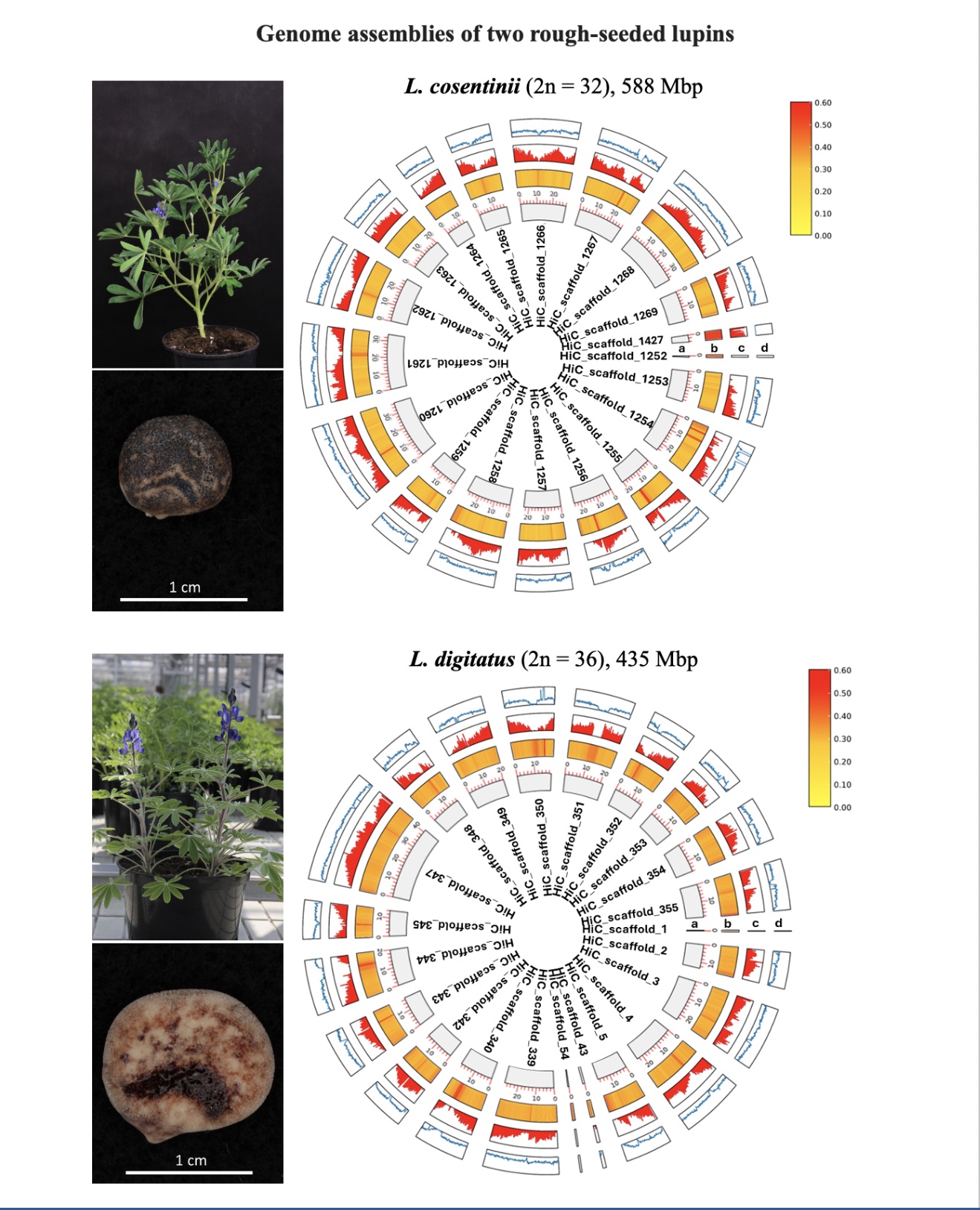- Leonardo Vincenzi, Magdalena Tomaszewska, Magdalena Kroc, Edoardo Franco, Emanuela Cosentino, Antonina Rita Limongi, Umesh Kumar Tanwar, Humaira Jamil, Matthew Nicholas Nelson, Philipp E. Bayer, David Edwards, Roberto Papa, Massimo Delledonne, Scott A. Jackson
- Nature Communication
- 2025
-
Lupin crops provide nutritious seeds as an excellent source of dietary protein. However, extensive genomic resources are needed for crop improvement, focusing on key traits such as nutritional value and climate resiliency, to ensure global food security based on sustainable and healthy diets for all. Such resources can be derived either from related lupin species or crop wild relatives, which represent a large and untapped source of genetic variation for crop improvement. Here, we report genome assemblies of the cross compatible species Lupinus cosentinii Mediterranean) and its pan-Saharan wild relative L. digitatus, which are well adapted to drought-prone environments and partially domesticated. We show that both species are tetraploids, and their repetitive DNA content differs considerably from that of the main lupin crops L. angustifolius and L. albus. We present the complex evolutionary process within the rough-seeded lupins as a species-based model involving polyploidization and rediploidization. Our data also provide the foundation for a systematic analysis of genomic diversity among lupin species to promote their exploitation for crop improvement and sustainable agriculture
-

Lcos_LdigWGS2025-7b05ce3d
Genome assemblies and annotations of L. cosentinii, left panel shows L. cosentinii plant and seed. Genome assemblies and annotations of L. digitatus, left panel shows L. digitatus plant and seed. (1) Circular maps. (2) GC content of the genomes. (3) Gene density. (4) Repetitive element density. - Susek et al., 2025
Susek et al., 2025 -
2025. The unexplored diversity of rough-seeded lupins provides rich genomic resources and insights into lupin evolution. Legume Hub. https://www.legumehub.eu
-
Susek K, Vincenzi L, Tomaszewska M, Kroc M, Franco E, Cosentino E, Limongi AR, Tanwar UK, Jamil H, Nelson MN, Bayer PE, Edwards D, Papa R, Delledonne M, Jackson SA. The unexplored diversity of rough-seeded lupins provides rich genomic resources and insights into lupin evolution. Nat Commun. 2025 May 10;16(1):4358. doi: 10.1038/s41467-025-58531-w.
The unexplored diversity of rough-seeded lupins provides rich genomic resources and insights into lupin evolution
Posted: 09.10.2025
Lupin crops provide nutritious seeds as an excellent source of dietary protein. However, extensive genomic resources are needed for crop improvement, focusing on key traits such as nutritional value and climate resiliency, to ensure global food security based on sustainable and healthy diets for all. Such resources can be derived either from related lupin species or crop wild relatives, which represent a large and untapped source of genetic variation for crop improvement. Here, we report genome assemblies of the cross compatible species Lupinus cosentinii Mediterranean) and its pan-Saharan wild relative L. digitatus, which are well adapted to drought-prone environments and partially domesticated. We show that both species are tetraploids, and their repetitive DNA content differs considerably from that of the main lupin crops L. angustifolius and L. albus. We present the complex evolutionary process within the rough-seeded lupins as a species-based model involving polyploidization and rediploidization. Our data also provide the foundation for a systematic analysis of genomic diversity among lupin species to promote their exploitation for crop improvement and sustainable agriculture
Downloads
About this article
Acknowledgement: This study was supported by the National Science Centre, Poland (grant nos. HARMONIA 7 2015/18/M/NZ2/00422 and OPUS 18 2019/35/B/NZ8/04283 to KS). We acknowledge the support provided by the Horizon 2020 Project INCREASE, grant agreement number 862862 (R.P. and K.S.; https://www.pulsesincrease.eu). INCREASE has received funding from the European Union’s Horizon 2020 research and innovation programme under grant agreement no. 862862. This publication reflects only the author’s view and neither the Research Executive Agency (REA) nor the European Commission are responsible for any use that may be made of the information it contains.
For matters related to publisher, citation and copyright, please refer to the original article.
The content is solely the responsibility of the authors. No warranties, expressed or implied, are made with respect to the information provided. Information relating to the use of plant protection products (pesticides) must be checked against the product label or other sources of product registration information.



0 Comments